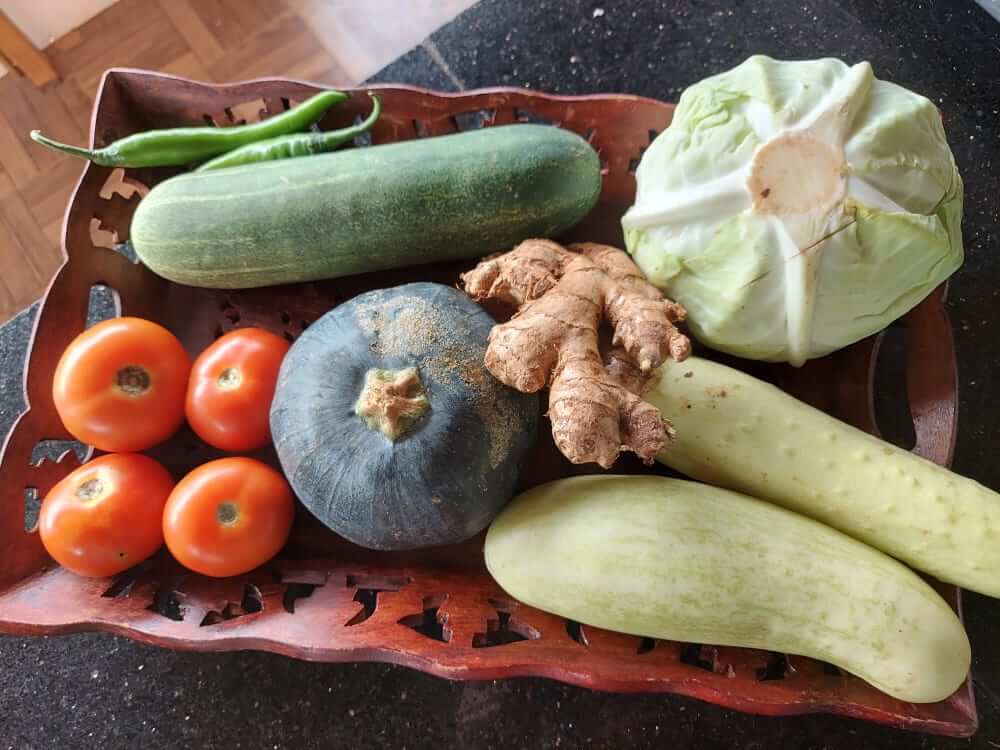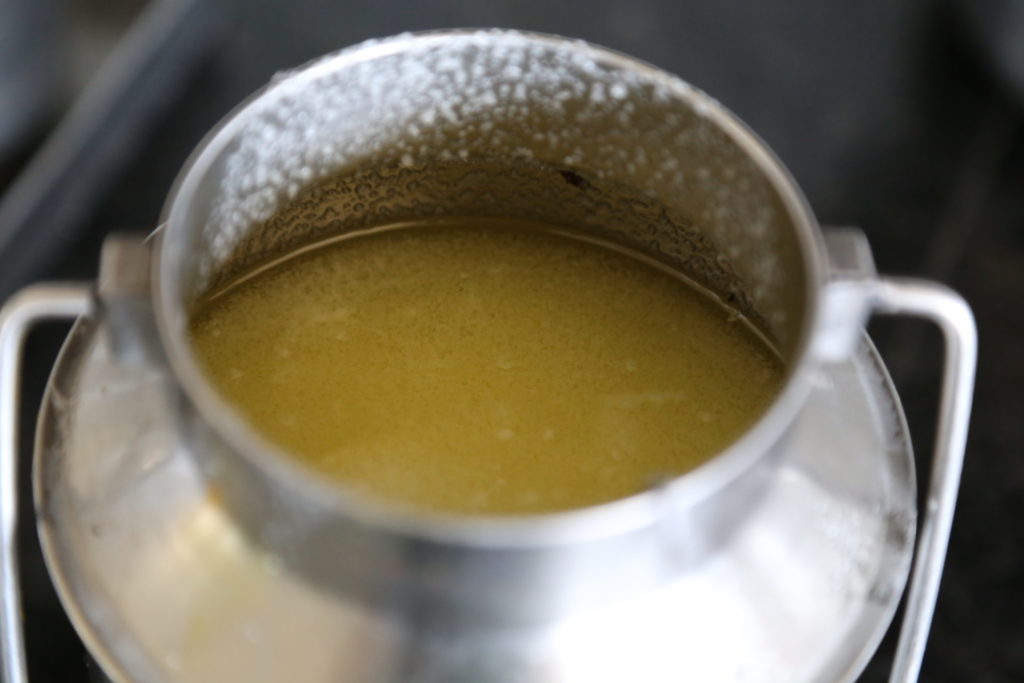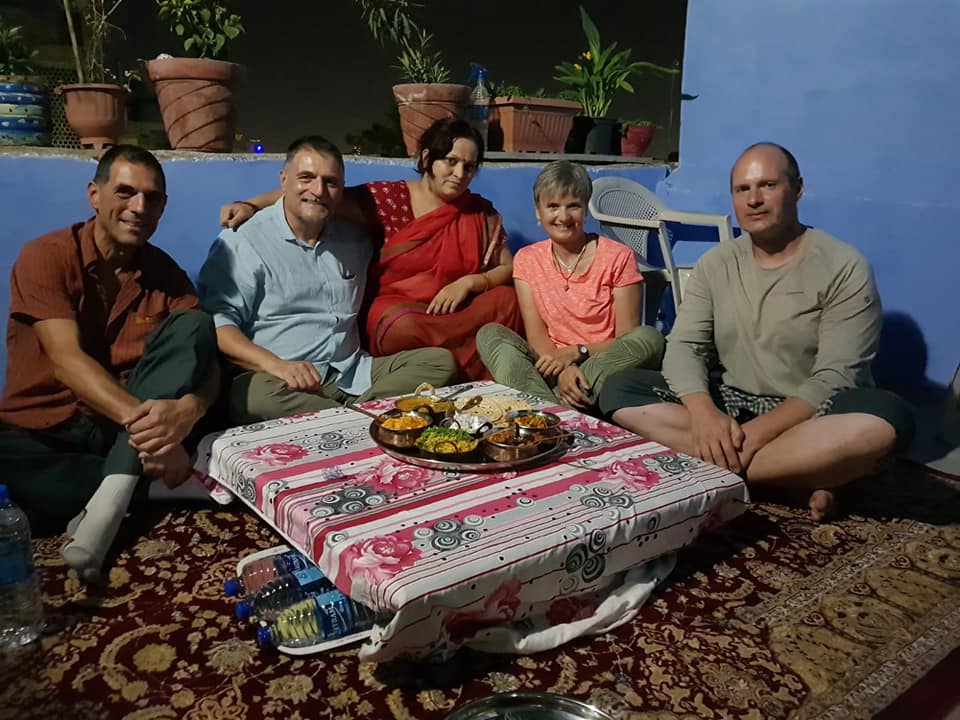Another article of mine in the Ayurveda series. As you can read, after my training I am still completely in Ayurveda fever. At the moment I am also working on a two-week Ayurveda and Yoga online retreat. So for me everything revolves around Ayurveda at the moment and that also feels really good in everyday life!
The subject of nutrition in Ayurveda is of course huge. In addition to the Pancha Karma cures and applications, medicinal herbs and the Ayurvedic lifestyle, everything else in Ayurveda actually revolves around nutrition. It’s just so crucial to our health. It is not for nothing that Ayurveda says “You are what you digest!”.

Since the subject is so complex, I would like to give only a small introduction today and I will adhere to the eight principles of Ayurvedic nutrition. It is very likely that I will take up the topic in more detail in the future. So here’s a little insight for those new to Ayurveda.
Principle number 1: Prakruti- the nature of the food
In Ayurveda, just like every living being, one ascribes certain properties to every food that are, so to speak, “innate” in the food.
In Ayurveda, 10 opposing pairs of the so-called Gunas (qualities) are known.
HEAVY LIGHT
COLD WARM
OILY – DRY
BLUNT-SHARP
SMOOTH – ROUGH
SEAL – LIQUID
SOFT HARD
STABLE – MOBILE
LARGE – SUBTLE
CLOUDY – CLEAR
Food can be heavy (meat) or light (green lentils); be oily (oily fish) or dry (toasted bread). Based on the prakruti of foods, one can choose the foods that are best suited to one’s condition. Note: opposites balance each other out. If you’re a bit flighty and hectic, choose a grounding and stabilizing food like potatoes or other root vegetables. If you are a little sluggish, cook with a little more hot pepper.
In addition, the 6 tastes (rasas) influence the quality of every food.
Every taste is created by combining two elements and has certain properties, as well as an important benefit for the body and positive effects on the mind, but can also have a negative effect if consumed in excess. In addition, the tastes also have a direct influence on the doshas. In Ayurveda, you see tastes in a similar way to nutrients and you try to absorb all of the tastes in one meal or at least in one day. It’s best to start with something sweet. This immediately stimulates the digestive juices and gives satisfaction in advance. You should end with the astringent taste. This signals to the body that it has finished eating.
| Rasa | elements | Guna | Positive | Negative | Dosha increase | example |
| Madhura Sweet | Earth + water | Cool, heavy, oily | Strengthens, nourishes the Dhatus, building, immune system, Ojas, love, compassion, pleasant | Obesity, diabetes, cholesterol, heaviness, indolence, possessiveness, greed | K | Sugar, ripe fruits, foods rich in carbohydrates, dairy products |
| Amla Sauer | Earth + fire | Light, hot, oily | Improves the taste of food, digestion, nourishes the body, pleases the mind, strengthens and sharpens sensory organs | Excessive thirst, tooth enamel, goose bumps, skin infections, blinking of the eyes, sores in the mouth, excited and hyperactive mind, envy, criticism | PK | Sour, unripe fruits, berries, fermented foods |
| Lavana Salty | Water + fire | hot, oily, heavy | Maintains electrolyte balance, digestion, bowel evacuation, removes toxins, interest, enthusiasm, | Thirst, dizziness, heat, hyperacidity, high blood pressure, skin problems, | PK | Sea salt, rock salt, nuts, fish |
| Katu Sharp | Air + fire | Hot, dry, light | Cleans the mouth, improves digestion, sharpens the senses, relieves pain, purifies the blood, appetite, enthusiasm, clarity | Impotence, unconsciousness, anger, violence, irritation | PV | Chilly, mustard, garlic, ginger, cloves, cinnamon, |
| Tikta bitter | Air + space | Cold, dry, light | Improves the taste, kills bacteria and viruses, relieves burning and itching, improves skin problems, relieves thirst, strengthens and stabilizes the body, liver tonic, improves digestion, clears the mind and senses, self-awareness | Dryness, roughness, rasa dhatu, sadness, loneliness, worry | V. | Neem, turmeric, aloe vera, leafy vegetables, coffee, cabbage |
| Kashaya pulling together | Air + earth | Heavy, dry, cool | Calming, healing, perception, focused, organized | Sperm count, dry mouth, pressure and pain in the chest and heart, insomnia, anxiety, depression, restlessness | V. | Unripe bananas, pomegranate, okra, lentils, Sharon fruit |

In Ayurveda, 12 different food groups are known which, due to their similar properties, have certain positive effects for us.These food groups differ a bit from the classification used in modern nutritional science:
- Grain: restorative, calming, nourishing
- Vegetables: vitalizing, mobilizing
- Fruits: toning, building tissue
- Green salad, raw vegetables: appetizing, flavorful
- Legumes: stabilizing, energizing
- Milk and dairy products: life giving, calming
- Alcohols, fermented foods: invigorating, invigorating, immunizing
- Meat: tissue-building, stabilizing
- Sugar (products): Nourishing
- Water: Satisfactory
- Additives (oils, spices): stimulating, digestive
- Prepared food: nourishing, strengthening, soothing
There are also 4 food groups that are determined by how they are consumed. Just as you should integrate all tastes, gunas and food groups into your food according to your own constitution, you can also integrate this aspect. An example here would be the Indian thali:

- Edible (rice, softened cooked vegetables)
- Drinkable (soups, liquid dal)
- Suckable (chutney, dessert)
- Chewable (chapati, bread, hard vegetables)
Principle number 2: Karana – The preparation

There are hundreds of different ways that food can be prepared. Ayurveda mentions among other things:
- Adding water or heat
- The cleaning, stirring and mixing
- The seasoning
- Make that durable
- The storage …
Depending on the preparation, the quality of the food can be changed and thus made more digestible.
For example, washing the rice with water will make the rice lighter, and while yogurt can cause puffiness, stirring into buttermilk negates this property.
Sometimes the preparation can make food poisonous. This happens, for example, when you heat honey.
3rd principle: Samyoga combinations
In Ayurveda, combinations play a very important role.
When two or more foods are combined, completely new qualities are created. These can be good or bad for us. Most foods are healthy in their own right.
However, eating some together at the same time greatly affects the digestive fire. The food cannot then be digested properly; toxins (ama) are created which the body has to excrete.

According to Ayurveda, honey and ghee should not be mixed at the same time, fruit and dairy products or grains are bad combinations, as well as the combination of different proteins.
According to Ayurveda, it is also not advisable to mix foods with different qualities – this confuses Agni, the digestive fire. If you should do this, at least cook the foods together in one pot, so they will adapt better to each other.
The following combinations should be avoided:
- After cold food or cold drinks, nothing should be consumed that is warm or hot.
- Milk should not be drunk cold. It is also important to avoid certain mixed drinks made from milk and fruit. With the wrong ingredients, these severely hinder digestion and block blood and lymph vessels, which can lead to diseases and skin problems. In addition, milk should not be eaten with meat, fish, yogurt, radish, garlic, green leafy vegetables and salt. The addition of spices can aid digestion: ginger, cinnamon, cardamom, and turmeric help.
- Never combine lemons with cucumbers, milk, tomatoes or yogurt.
- Honey must never be consumed in equal proportions with butter / ghee. That is very toxic. In addition, it should not be heated.
- Eggs don’t go well with cheese, fish, bananas, melons, milk, and meat.
- Nightshade plants (tomatoes, potatoes, aubergines) should not be consumed with meat, fish, cucumber or dairy products.
- Avoid meat in combination with milk, radish, sprouts, honey and sesame.
- Do not combine starchy foods with fruit, milk and eggs. Above all, starch and fructose do not get along well and digestion becomes sluggish.
- Do not mix: hot and cold food, raw and cooked food, fresh and old food
4th principle: Rashi – the crowd

This refers to the total amount of the meal on the one hand and the amounts of the individual ingredients, i.e. the recipe, on the other.
Ayurveda does not advise eating too much or too little. There should be a comfortable and satisfying feeling after the meal. It is best to fill the stomach halfway with food, one fourth with liquid and the last quarter remains empty so that our Agni is not suffocated.
5th principle: Deshan- The place where we eat and where the food comes from
Depending on where the food comes from, it also has a different quality. In general, Ayurveda always recommends eating regionally, as the food in the region in which we are located has the ideal properties for our diet. Food intake also depends on the place where we live. In cold regions, for example, people tend to eat warm and heavy, while in desert regions light and cool foods are preferred.
6. Principle: Kala – the time
In Ayurveda, the time of day and season generally play an important role in nutrition.
For example, you should have your main meal at lunchtime, when the Pitta Dosha and digestion is at its highest. In addition, one should only eat when one is hungry and keep enough distance between meals so that the previous meal is really digested and one does not overtax one’s agni. Signs of complete digestion are:
- Light body feeling
- No belching
- hunger and thirst
- enthusiasm
- Normal regulation of natural urges
In the dry autumn you prefer warm soups, in the spring time you prefer light food that loosens the gravity and in summer it can also be a crunchy salad or a cooling buttermilk.
Kala also means certain stages in which one is. This can be a diet adapted to the age or an illness.
7th principle: Upayogas Samstha rules for the way of ingesting food
Another important aspect is our eating culture. Meals should be relaxed, friendly and in a clean atmosphere. This is more digestible for our digestion and psyche. Mindfulness also plays an important role here! In addition, Ayurveda also has many practical rules here so that digestion works better:
- Wash before you eat
- Don’t eat with a full bowel or bladder
- Be appropriately dressed
- Say a prayer and think of God, ancestors, teachers, parents, guests
- Eat from clean dishes
- Don’t eat when you don’t have an appetite
- Do not eat with enemies or in front of the hungry
- Eat warm and freshly prepared food
- Have your main meal at lunchtime
- Don’t eat too late in the evening
- Sit upright and raised enough to eat, facing east or north
- Eat moist, oily foods
- Eat the right amount
- Chew your food well
- Don’t eat yogurt in the evening
- Don’t eat too slowly or too quickly
- Take breaks between meals and do not eat again until the last meal has been digested and you feel hungry again
- Eat regularly
- Only drink small sips of warm water with your meal and nothing immediately before or after your meal
- Don’t eat when you’re emotional
- Eat in a peaceful atmosphere
- Sit while eating
- Eat mindfully
- Sit for a moment after eating
- Don’t laugh or talk while you eat
- Make your food intake personal
8. Principle: Upayokta – The eater and the inner attitude

Of course, especially in Ayurveda, the diet depends on the person individually. Both the basic state and the current state of the person are taken into account. Care should be taken to ensure a positive mood both when preparing and when taking the food. Not only does food taste better from happy cooks, but happy and mindful eaters can digest better too. The issue of spiritual purity also plays a role here. Even today cooks in ashrams in India purify themselves spiritually and through meditation in order to give the food a very special energy.
Perhaps I was able to inspire you with these principles of Ayurvedic nutrition to integrate Ayurvedic nutrition yourself into your everyday life. The best thing about it: It is individually adapted to each individual and not dogmatic at all.





